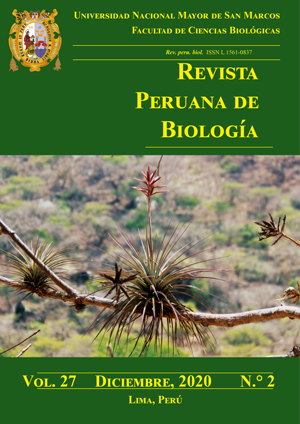Molecular identification and evolutionary relationships of Pomacea nobilis, basis for the specific authentication of the black apple snail from Peruvian Amazonia
DOI:
https://doi.org/10.15381/rpb.v27i2.17875Keywords:
COI, Molecular phylogeny, authentication, Ampullariidae, Amazonia, DNA barcoding, molecular identification, Taxonomy, Species identification, apple snailsAbstract
In the Peruvian Amazon, freshwater snails of the Ampullariidae family are known as churos, and around 20 species have originally been described for Peru. Although they are widely used for food, traditional medicine and the object of many studies for their cultivation and industrialization, only the species Pomacea maculata is mentioned in the literature. Molecular identification was carried out based on the mitochondrial marker COI of individuals of "churo negro" apple snails (Pomacea) commercialized in the markets of Iquitos, as well as those used in restaurant dishes in the city of Lima, and contrasted with specimens from their natural habitat. It was found that these specimens, correspond to the species Pomacea nobilis (Reeve, 1856). The molecular phylogenetic analysis showed P. nobilis as the sister species of P. guyanensis, in the P. glauca group, distantly related to P. maculata. The uncorrected distances found between them, for the mitochondrial marker COI, were from 11.33% to 13.17%, while with P. maculate were from 13.67% to 15.33%. These results demonstrated the effectiveness of the DNA barcode for the identification and authentication of the species, which gives it added value for its eventual export trade.
Downloads
Downloads
Published
Issue
Section
License
Copyright (c) 2020 Rina Ramírez, Maria Solis, André Ampuero, Jaime Morín, Victor Jimenez-Vasquez, Jorge L. Ramirez, Carlos Congrains, Haydee Temoche, Betty Shiga

This work is licensed under a Creative Commons Attribution-NonCommercial-ShareAlike 4.0 International License.
AUTHORS RETAIN THEIR RIGHTS:
a. Authors retain their trade mark rights and patent, and also on any process or procedure described in the article.
b. Authors retain their right to share, copy, distribute, perform and publicly communicate their article (eg, to place their article in an institutional repository or publish it in a book), with an acknowledgment of its initial publication in the Revista Peruana de Biologia.
c. Authors retain theirs right to make a subsequent publication of their work, to use the article or any part thereof (eg a compilation of his papers, lecture notes, thesis, or a book), always indicating its initial publication in the Revista Peruana de Biologia (the originator of the work, journal, volume, number and date).






